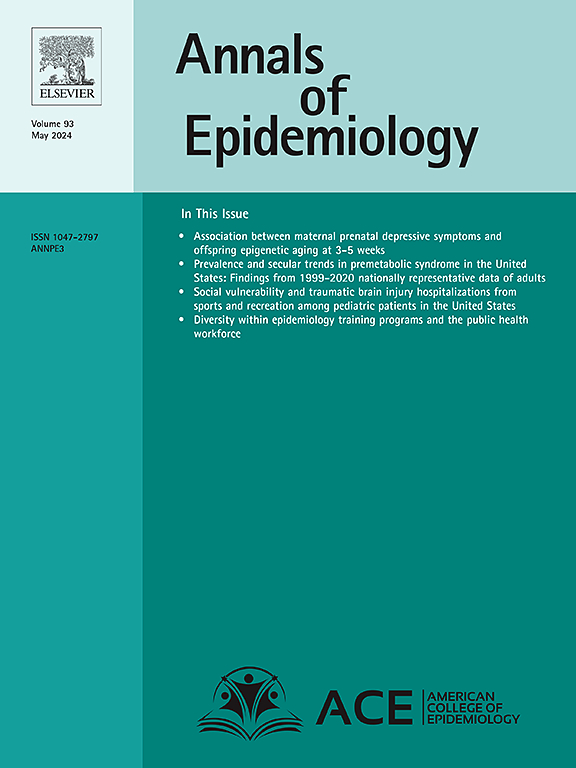Associations of pregnancy timing relative to the COVID-19 pandemic, maternal SARS-CoV-2 infection, and adverse perinatal outcomes
IF 3.3
3区 医学
Q1 PUBLIC, ENVIRONMENTAL & OCCUPATIONAL HEALTH
引用次数: 0
Abstract
Purpose
To examine associations between pregnancy timing relative to the COVID-19 pandemic, maternal SARS-CoV-2 infection, and perinatal outcomes.
Methods
We conducted a retrospective cohort study of 189,097 singleton births in South Carolina (2018–2021). Pregnancy timing relative to the pandemic was classified as pre-pandemic (delivered before March 1, 2020), partial pandemic overlap (conceived before and delivered during the pandemic), or pandemic (conceived and delivered during the pandemic). We examined COVID-19 testing, severity, and timing. Modified Poisson regression models with robust variance were used.
Results
Compared to the pre-pandemic group, the partial overlap group had lower risks of low birthweight (LBW) (aRR=0.93, 95 % CI 0.89–0.97) and preterm birth (PTB) (aRR=0.91, 95 % CI 0.88–0.95). The pandemic group had increased risks of LBW (aRR=1.10, 95 % CI 1.06–1.14), PTB (aRR=1.10, 95 % CI 1.07–1.14), and NICU admissions (aRR=1.13, 95 % CI 1.09–1.17) but a decreased risk of breastfeeding initiation (aRR=0.98, 95 % CI 0.97–0.98). Moderate-to-severe COVID-19 symptoms increased PTB (aRR=1.34, 95 % CI 1.13–1.58). Third-trimester COVID-19 infection increased LBW (aRR=1.23, 95 % CI 1.10–1.37), PTB (aRR=1.18, 95 % CI 1.07–1.30), and NICU admissions (aRR=1.17, 95 % CI 1.05–1.30).
Conclusions
Our findings highlight the importance of considering both maternal COVID-19 infection and pandemic-related factors in optimizing perinatal outcomes.
妊娠时机与COVID-19大流行、母体SARS-CoV-2感染和不良围产期结局的关联
目的:探讨COVID-19大流行与孕产妇SARS-CoV-2感染与围产期结局的关系。方法:我们对南卡罗来纳州(2018-2021)的189,097例单胎进行了回顾性队列研究。与大流行相关的怀孕时间被归类为大流行前(在2020年3月1日之前分娩)、大流行部分重叠(在大流行之前怀孕并在大流行期间分娩)或大流行(在大流行期间怀孕和分娩)。我们检查了COVID-19的检测、严重程度和时间。采用修正的泊松回归模型和稳健方差。结果:与大流行前组相比,部分重叠组低出生体重(LBW) (aRR=0.93, 95% CI 0.89-0.97)和早产(PTB) (aRR=0.91, 95% CI 0.88-0.95)的风险较低。大流行组发生LBW (aRR=1.10, 95% CI 1.06-1.14)、PTB (aRR=1.10, 95% CI 1.07-1.14)和NICU入院(aRR=1.13, 95% CI 1.09-1.17)的风险增加,但开始母乳喂养的风险降低(aRR=0.98, 95% CI 0.97-0.98)。中至重度COVID-19症状增加PTB (aRR=1.34, 95% CI 1.13-1.58)。妊娠晚期COVID-19感染增加了LBW (aRR=1.23, 95% CI 1.10-1.37)、PTB (aRR=1.18, 95% CI 1.07-1.30)和NICU入院率(aRR=1.17, 95% CI 1.05-1.30)。结论:我们的研究结果强调了在优化围产期结局时同时考虑孕产妇COVID-19感染和大流行相关因素的重要性。
本文章由计算机程序翻译,如有差异,请以英文原文为准。
求助全文
约1分钟内获得全文
求助全文
来源期刊

Annals of Epidemiology
医学-公共卫生、环境卫生与职业卫生
CiteScore
7.40
自引率
1.80%
发文量
207
审稿时长
59 days
期刊介绍:
The journal emphasizes the application of epidemiologic methods to issues that affect the distribution and determinants of human illness in diverse contexts. Its primary focus is on chronic and acute conditions of diverse etiologies and of major importance to clinical medicine, public health, and health care delivery.
 求助内容:
求助内容: 应助结果提醒方式:
应助结果提醒方式:


